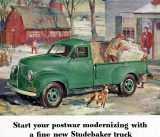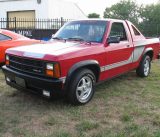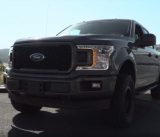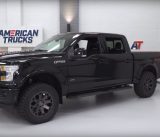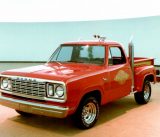
Source: Shutterstock
Post WWII, Chevrolet undertook some serious research. They wanted to know what their American consumers were seeking in a pickup truck.
Their designers came up with what they called the “Advanced Design Series,” a series of pickups Chevy ended up manufacturing from 1947 to 1955. (After 1955, they were replaced by the Task Force truck series.) Known for their state-of-the-art mechanics and cutting-edge construction, these trucks were actually considered a radical step forward in comparison to the manufacturer’s earlier AK Series.
The Advanced Series, which included canopy express, Suburban, cab over, canopy express, and panel trucks, were marketed as the perfect work vehicles for the “modern” man. Sold at GMC locations across the country, these new Chevy models topped nationwide truck sales between 1947 and 1955.

Source: Shutterstock
The 3100 was the highly customizable base model. Offered with a wide range of optional add-ons—from engine upgrades to chrome accenting—it would be remembered for its sleek styling. Along with the 3600 and the 3800, the 3100 was different from anything consumers had seen before. All Advanced Design pickups featured rounded fenders and recessed headlights. The body was smooth and aerodynamic. The nostalgics among us believe that from their very conception, they were destined to be remembered.
But the Advanced Series trucks came with some practical upgrades, too. The cabs, which were eight inches wider and seven longer than the previous line, were completely welded. That might not seem revolutionary to us now, but it was back then, allowing for Chevy’s first-ever three-man cab in a pickup. The seats were fully adjustable. Inside, drivers had the luxury of a windshield defrosting and fresh-air heating system which brought outside air into the cab and sent used air through the cab’s rear-facing vents.
Weighing half a ton, the 3100 was a lightweight compared to the three-quarter-ton 3600 and the one-ton 3800. It came with 92 horsepower, a 216.5-cubic inch six-cylinder, inline engine, and 174 foot-pounds of torque—which admittedly, doesn’t sound like much today. Keep in mind, this was seven decades years ago. Those 174 foot-pounds of torque allowed the 3100 to speed up relatively quickly and haul some pretty heavy loads for its day.

Source: Shutterstock
The base model came standard with a three-speed manual transmission, with a four-speed floor-mounted shifter as an option. As the truck was nearing the end of its production run, Chevrolet renewed the engine, replacing the 216.5-cubic inch six-cylinder with a 235.5-cubic inch straight six cylinder that boasted 112 horsepower and 200 foot-pounds of torque. (Automatic transmissions were introduced in Chevy trucks in 1964.)
After an eight-year run, these Chevrolet trucks were still number one in sales on the day they were discontinued: March 25, 1955. The reasoning behind the decision was that Americans were slowly but surely demanding more powerful vehicles. The 3100 was discontinued to make way for something more powerful, with a V8 engine.
Today, most of these work trucks exist as relics from another time. Their look is an homage to both the post-war era and Americana. Timeless engineering, progressive styling, and a truly powerful machine for its time, make the 3100 truly exemplary of the American automobile industry at the height of its glory. These trucks are sure to be remembered for years to come, both for their service to national industry and their innovative design.

